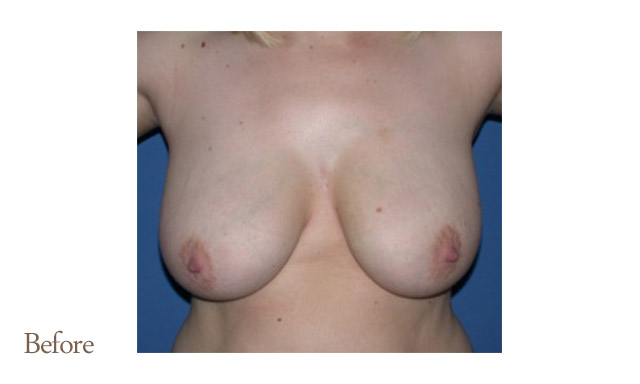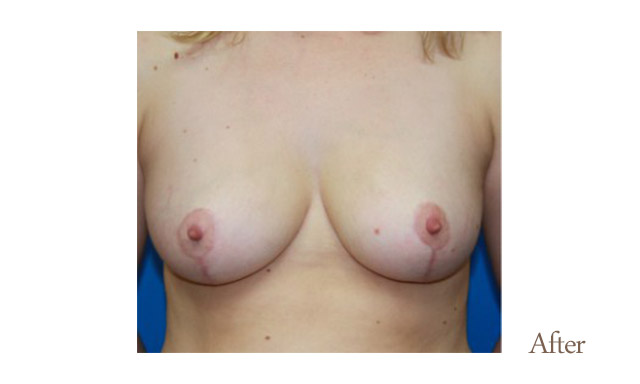Breast Reduction (Reduction Mammaplasty)
Large breasts can cause pain, improper posture, rashes, breathing problems, skeletal deformities, and low self-esteem. Breast reduction surgery, also known as reduction mammaplasty, is usually done to provide relief from these symptoms. Performed under general anesthesia, this procedure removes fat and glandular tissue and tightens skin to produce smaller, lighter breasts that are in a healthier proportion to the rest of the body.

Initial Consultation
It is important to consider each aspect of the breast reduction procedure and your life after surgery before deciding upon the procedure. Prior to the procedure, Dr. Spann will meet with you to discuss your expectations for breast reduction surgery. He can then evaluate which goals are within reach and propose a plan for the breast reduction operation. At that time, Dr. Spann will inform you about the risks and possible complications of breast reduction surgery and the long-term effects of undergoing a breast reduction.
Benefits of Breast Reduction
Women with large, heavy breasts may suffer physical pain from the weight of their breasts and may experience social discomfort due to unwanted attention to their breast size. Because of this, many women turn to breast reduction as a remedy.
Large, heavy breasts can also cause strain on a woman’s body. The extra weight of heavy breasts can be harmful to posture and may lead to spinal problems. In addition to causing back, neck, and shoulder pain, excessively heavy breasts may also lead to breathing problems and other serious health issues. Breast reduction surgery can help a woman correct her posture and remove strain on the back, neck, and shoulders, reducing overall pain.
In addition to seeking relief from the pain caused by heavy breasts, many women seek breast reduction surgery because they are uncomfortable with the unwanted attention that their breast size draws. This unwanted attention may cause a woman to become uncomfortable with her appearance. Breast reduction surgery can help a woman regain her self-confidence and positive self-image, as well as provide the motivation to participate in a wide range of physical and social activities.
Incision Techniques
Breast reduction surgery generally takes two to four hours, depending on the patient’s specific case, and is performed under general anesthesia. The size and shape of your breasts, as well as the desired amount of reduction, helps determine which type of incision is right for you. The different types of incisions for a breast reduction include:
The traditional approach to breast reduction surgery is a very effective method for alleviating discomfort caused by large, heavy breasts. The traditional method, also called an anchor pattern or Wise pattern reduction, is often the best choice for women requiring a large amount of tissue removal. In the traditional breast reduction surgery technique, incisions are made horizontally under the breast in the crease and extend vertically up to and around the nipple, creating an anchor pattern.
Because traditional breast reduction surgery allows for excess skin removal both vertically and horizontally, it is typically the best method for women with extremely large breasts. The anchor shaped incision also allows surgeons to remove more tissue than other methods, maximizing breast reduction results. Although the anchor pattern method can be useful in reducing excessively large breasts, it leads to more scarring than other breast reduction surgery techniques. These scars can often be hidden by bathing suits and even low cut tops.
Procedure
Breast reduction surgery generally takes a few hours, depending on the patient’s specific case, and is performed under general anesthesia.
In traditional incision breast reduction, skin, fat, and tissue from the lower breast area are removed to reduce the mass of the breast. In most cases, the nipples are moved to a higher position on the breast, but remain attached to the nerves and blood vessels. For very large breasts, however, the nipples may need to be moved and grafted to a completely new location. In these situations, you will lose sensation in the nipple and areola. After the nipple is moved to its new position, the skin above the nipple is brought down and around the swell of the breast, and then stitched back to close the original incision.
In vertical incision breast reduction, a lollipop-shaped incision is made around the areola and down the breast. After the breast tissue and skin is removed, Dr. Spann will stitch up the incision by folding the excess skin over itself on the breast. The nipple can still be moved up in a method similar to that of the traditional procedure, but not more than a few millimeters.
In scarless breast reduction, only one very small incision will be made in the breast crease. A thin surgical tube, called a cannula, is inserted in order to liposuction out excess fatty breast tissue. This technique is considered a scarless breast reduction procedure because the scars are minimal and usually invisible due to their inconspicuous location under the breast.
Recovery
Initially after breast reduction surgery, your breasts will be sore, swollen, and bruised. You can expect to wear bandages for about two days after surgery. Activity should be kept to a minimum for one to two weeks. You should also avoid heavy lifting and refrain from exercise and other strenuous activities for at least four weeks following the procedure. For extra support, a special soft surgical bra or athletic bra may be recommended.
Stitches will be removed in two to three weeks after the breast reduction procedure. Most women will be able to return to work and other normal activities about two weeks after undergoing a breast reduction. To ensure that the breasts are healing properly, breast reduction patients should attend follow-up appointments for several months after surgery.
Risk and Complications
Dr. Spann performs breast reduction surgery with great care and precision, ensuring safe results that generally meet the expectations of his/her patients. As with all surgeries, however, complications can occur. Potential risks that are specific to breast reduction surgery include asymmetrical breasts or an altered or lost nipple and areola sensation. Dr. Spann will make sure to discuss these with you to help you decide if breast reduction is right for you.
Breast Reduction FAQs
Women with large, disproportionate breasts who experience pain, discomfort, and embarrassment due to their breast size may be good candidates for breast reduction surgery. Ideal candidates for breast reduction are women who are not pregnant or breastfeeding. Although the procedure is generally recommended for mature women with fully developed breasts, breast reduction surgery can be performed on younger women if their breasts are causing serious pain and physical discomfort.
After breast reduction surgery, it is often possible to return to work within just a couple of weeks, depending on your job. Many patients can resume most of their normal activities, including some form of mild exercise, within a few weeks as well. You may continue to experience some mild, periodic discomfort during this time, but these feelings are normal.
Because sexual arousal could cause incisions to swell and create the possibility of delayed healing, sexual activity should be avoided for at least one week after breast reduction surgery.
Many patients are concerned that limited mobility after surgery may prevent them from showering for several days. Dr. Spann actually recommends that patients shower as soon as possible after surgery to help them feel refreshed and able to move up and about.
Breast reduction may be covered by medical insurance if the purpose of the breast reduction surgery is to alleviate physical discomfort and pain caused by oversized breasts. Many factors determine your eligibility, including the specific terms of your insurance policy and the amount of breast tissue to be removed.
After breast reduction surgery, breasts will remain smaller than they would be if the procedure had never been performed. Unless you gain or lose a significant amount of weight or become pregnant, your breast size should remain fairly constant. However, the effects of aging and gravity may cause breasts to sag over time. If, after a period of years, you become dissatisfied with the appearance of your breasts, you may choose to undergo a breast lift procedure to restore their more youthful contour.
The various techniques for breast reduction produce different types of possible scarring. Traditional breast reduction surgery will produce anchor-like scars that extend around the nipple, down the middle of the breast, and under the breast. Vertical incision breast reduction surgery creates shorter scars which also circle the nipple and extend vertically down the breast, but do not continue under the breast. Scarless breast reduction surgery typically only leaves minor, inconspicuous scars that are usually under the breast crease.
Avoiding breast reduction surgery because of possible scarring is ill-advised, since the benefits of a breast reduction usually outweigh the appearance of scars. Scars from breast reduction also tend to fade over time and can usually be hidden under bras, bathing suits, or a low cut top.
There is a chance that breastfeeding may not be possible after breast reduction. The level of risk depends on the surgical technique used for the procedure.
- Traditional breast reduction surgery has the highest risk of affecting the ability to breastfeed. During this type of breast reduction, many of the milk ducts are removed, making it more difficult to breastfeed in the future.
- Vertical incision breast reduction surgery has a lower risk than traditional incisions since a portion of the nipple will remain connected to the milk ducts.
- Scarless breast reduction surgery has practically no risk of affecting breastfeeding because this breast reduction technique leaves the glandular and connective tissue largely untouched.
Breast reduction surgery may have potential complications that are possible for all surgeries, including bleeding, infection, hematoma, adverse reactions to anesthesia, and scarring. Potential risks that are specific to breast reduction surgery include asymmetrical breasts, altered or loss of nipple and areola sensitivity, and the inability to breastfeed.


